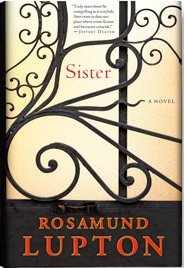I just finished reading Sister: A Novel, by Rosamund Lupton. The book has gotten generally very good reviews, but I found it to be a pretty big disappointment. The book has a very specific literary device that it relies on for its structure, and I found the device to be both confusing and annoying. This could be because I read ebooks on my iPhone, and perhaps the font was too small to pick up on the all-important quotation marks.
The device is this: the story is told in the first person as if it is being spoken or written (it is not made clear which). The main character, Beatrice, is speaking to her recently-deceased sister, Tess. She is telling Tess the story of how Tess’s body was discovered, and how the police believed that she had committed suicide. Beatrice is the only person who believes that her sister was murdered.
The novel suffers terribly from a form of past/present/future tense vertigo. Beatrice talks to her dead sister about the distant past and the recent past in one sentence, and in the next sentence, she is speaking in her own voice in the present tense. She “speaks” one sentence to Tess in her head, and then the next sentence is spoken aloud to another character, and the only cue that she is now actually speaking aloud is those pesky quotation marks. If you happen to miss the begin quotations, you will find yourself reading along, thinking Beatrice is “speaking” in her head to Tess, only to realize that she is actually in a conversation with another character. This happened to me throughout the book.
If the plot device sounds confusing or convoluted, please realize that it is even more convoluted than it sounds here. To hold any sense of mystery, it is necessary for the story to unfold at a certain pace, and for details to come to light. Of course, since it is being told in the past tense, it is clear that the speaker already knows the details, and is speaking to a close relative who has been murdered, and who would therefore probably know who her own murderer was, so for it to be held back as a “secret” to be revealed at the end is simply gimmicky.
And that’s not the only gimmick up Rosamund Lupton’s sleeve. The ending of the book throws everything out the window and rewrites the entire story. I’m not saying it’s as annoying or fake as “and then I woke up and realized it was all a dream,” but it’s awfully close. It comes out of pretty much nowhere and makes no sense at all. And while “Sister: A Novel” is not a traditional mystery novel, it does play on the tropes of that genre, and one of the basic tenets of successful mystery writing is to have a great ending—to wrap things up in a way that pays off on the reader’s investment in the story up to that point. The “finish” of this book does just the opposite—it not only goes out with a whimper, the “reveal” actually makes what has come before less interesting.
I do give the author credit for taking a risk. I appreciate the effort to do something interesting or unusual. As my old acting teacher Shirley Kaplan would have said, “At least she tried something! At least she had an idea!” And Rosamund Lupton did have an idea, she did try something…and she failed. I guess that makes this an “A” for effort, but “C-“ for execution.